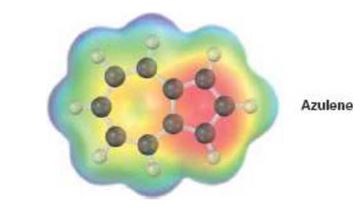
Organic Chemistry
9th Edition
ISBN: 9781305080485
Author: John E. McMurry
Publisher: Cengage Learning
expand_more
expand_more
format_list_bulleted
Concept explainers
Textbook Question
Chapter 15.SE, Problem 17VC
Azulene, an isomer of naphthalene, has a remarkably large dipole moment for a hydrocarbon (μ = 1.0 D). Explain, using resonance structures.

Expert Solution & Answer
Trending nowThis is a popular solution!

Students have asked these similar questions
None
Please correct answer and don't use hand rating
Describe the structural differences between iso- and heteropolyacids.
Chapter 15 Solutions
Organic Chemistry
Ch. 15.1 - Prob. 1PCh. 15.1 - Give IUPAC names for the following compounds:Ch. 15.1 - Prob. 3PCh. 15.2 - Pyridine is a flat, hexagonal molecule with bond...Ch. 15.3 - Prob. 5PCh. 15.4 - Draw the five resonance structures of the...Ch. 15.4 - Prob. 7PCh. 15.4 - Prob. 8PCh. 15.5 - Prob. 9PCh. 15.5 - Prob. 10P
Ch. 15.6 - Prob. 11PCh. 15.6 - How many electrons does each of the four nitrogen...Ch. 15.SE - Give IUPAC names for the following substances (red...Ch. 15.SE - All-cis cyclodecapentaene is a stable molecule...Ch. 15.SE - 1, 6-Methanonaphthalene has an interesting 1H NMR...Ch. 15.SE - Prob. 16VCCh. 15.SE - Azulene, an isomer of naphthalene, has a...Ch. 15.SE - Give IUPAC names for the following compounds:Ch. 15.SE - Draw structures corresponding to the following...Ch. 15.SE - Prob. 20APCh. 15.SE - Prob. 21APCh. 15.SE - Draw and name all possible aromatic compounds with...Ch. 15.SE - Propose structures for aromatic hydrocarbons that...Ch. 15.SE - Look at the three resonance structures of...Ch. 15.SE - Prob. 25APCh. 15.SE - Prob. 26APCh. 15.SE - Look at the five resonance structures for...Ch. 15.SE - Prob. 28APCh. 15.SE - 3-Chlorocyclopropene, on treatment with AgBF4,...Ch. 15.SE - Prob. 30APCh. 15.SE - Prob. 31APCh. 15.SE - Prob. 32APCh. 15.SE - Which would you expect to be most stable,...Ch. 15.SE - How might you convert 1, 3, 5, 7-cyclononatetraene...Ch. 15.SE - Calicene, like azulene (Problem 15-17), has an...Ch. 15.SE - Pentalene is a most elusive molecule that has been...Ch. 15.SE - Prob. 37APCh. 15.SE - Prob. 38APCh. 15.SE - Compound A, C8H10, yields three substitution...Ch. 15.SE - Prob. 40APCh. 15.SE - Propose structures for compounds that fit the...Ch. 15.SE - Prob. 42APCh. 15.SE - Prob. 43APCh. 15.SE - N-Phenylsydnone, so-named because it was first...Ch. 15.SE - Prob. 45APCh. 15.SE - Prob. 46APCh. 15.SE - Prob. 47APCh. 15.SE - Propose a structure for a molecule C14H12 that has...Ch. 15.SE - The proton NMR spectrum for a compound with...Ch. 15.SE - The proton NMR spectrum of a compound with formula...Ch. 15.SE - Aromatic substitution reactions occur by addition...Ch. 15.SE - Prob. 52APCh. 15.SE - Consider the aromatic anions below and their...Ch. 15.SE - After the reaction below, the chemical shift of Ha...Ch. 15.SE - Prob. 55APCh. 15.SE - Azo dyes are the major source of artificial color...
Knowledge Booster
Learn more about
Need a deep-dive on the concept behind this application? Look no further. Learn more about this topic, chemistry and related others by exploring similar questions and additional content below.Similar questions
- What is the pH of the Tris buffer after the addition of 10 mL of 0.01M NaOH? How would I calculate this?arrow_forwardWhy do isopolianions form polymeric species with a defined molecular weight? What does it depend on?arrow_forwardWhat are isopolianions? Describe the structural unit of isopolianions.arrow_forward
- Justify the polymerization of vanadates VO43-, as a function of concentration and pH.arrow_forwardWhat is the preparation of 500 mL of 100mM MOPS buffer (pH=7.5) starting with 1 M MOPS and 1 M NaOH? How would I calculate the math?arrow_forwardIndicate the correct option.a) Isopolianions are formed around metallic atoms in a low oxidation state.b) Non-metals such as N, S, C, Cl, ... give rise to polyacids (oxygenated).c) Both are incorrect.arrow_forward
- 14. Which one of the compounds below is the major organic product obtained from the following series of reactions? Br OH OH CH3O™ Na+ H*, H₂O SN2 HO OH A B C D 0 Earrow_forwardWavelength (nm) I'm not sure what equation I can come up with other than the one generated with my graph. Can you please show me the calculations that were used to find this equation? Give an equation that relates energy to wavelength. Explain how you arrived at your equation. Wavelength Energy (kJ/mol) (nm) 350 341.8 420 284.8 470 254.5 530 225.7 580 206.3 620 192.9 700 170.9 750 159.5 Energy vs. Wavelength (Graph 1) 400 350 y=-0.4367x+470.82 300 250 200 150 100 50 O 0 100 200 300 400 500 600 700 800 Energy (kJ/mol)arrow_forward5. Draw molecular orbital diagrams for superoxide (O2¯), and peroxide (O2²-). A good starting point would be MO diagram for O2 given in your textbook. Then: a) calculate bond orders in superoxide and in peroxide; indicate which species would have a stronger oxygen-oxygen bond; b) indicate which species would be a radical. (4 points)arrow_forward
- 16. Which one of the compunds below is the final product of the reaction sequence shown here? عملاء .OH Br. (CH3)2CH-C=C H+,H,O 2 mol H2, Pt A OH B OH D OH E OH C OHarrow_forwardIndicate whether any of the two options is correct.a) The most common coordination structure for isopolianions is the prismb) Heteropolianions incorporate alkaline cations into their structuresarrow_forwardPlease correct answer and don't use hand ratingarrow_forward
arrow_back_ios
SEE MORE QUESTIONS
arrow_forward_ios
Recommended textbooks for you

 Organic ChemistryChemistryISBN:9781305580350Author:William H. Brown, Brent L. Iverson, Eric Anslyn, Christopher S. FootePublisher:Cengage Learning
Organic ChemistryChemistryISBN:9781305580350Author:William H. Brown, Brent L. Iverson, Eric Anslyn, Christopher S. FootePublisher:Cengage Learning


Organic Chemistry
Chemistry
ISBN:9781305580350
Author:William H. Brown, Brent L. Iverson, Eric Anslyn, Christopher S. Foote
Publisher:Cengage Learning
Types of bonds; Author: Edspira;https://www.youtube.com/watch?v=Jj0V01Arebk;License: Standard YouTube License, CC-BY